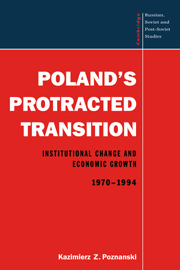Book contents
- Frontmatter
- Contents
- Preface
- Introduction: Research agenda, conceptual model and principal findings
- Part I Imperfect decentralization, broken political contracts and foreign-debt crisis
- Part II Economic reforms, divided society and ‘growth fatigue’
- Part III Communist legacy, ‘shock therapy’ and economic recession
- 7 Costly transition to ‘hard’ markets
- 8 Political coalitions and property reforms
- 9 The paradox of continuity in change
- Appendix
- Notes
- References
- Index
- Titles in the series
7 - Costly transition to ‘hard’ markets
Published online by Cambridge University Press: 29 October 2009
- Frontmatter
- Contents
- Preface
- Introduction: Research agenda, conceptual model and principal findings
- Part I Imperfect decentralization, broken political contracts and foreign-debt crisis
- Part II Economic reforms, divided society and ‘growth fatigue’
- Part III Communist legacy, ‘shock therapy’ and economic recession
- 7 Costly transition to ‘hard’ markets
- 8 Political coalitions and property reforms
- 9 The paradox of continuity in change
- Appendix
- Notes
- References
- Index
- Titles in the series
Summary
The communist party's relinquishment of political control in mid-1989 was a watershed event, taking many political participants by surprise. The general reaction to this development was to view it as a revolution of some sort, but due to the absence of violent clashes between outgoing and incoming power groups – a fact that we stressed earlier on numerous occasions – the term ‘peaceful revolution’ was widely adopted. This was to convey the feeling that although the power transfer was non-violent, the processes which were to follow this event would be quite momentous. The departure of the communist party was expected to be the trigger mechanism for fast-paced formation of both pluralistic, democratic politics and the reintroduction of economic freedoms – and by many accounts, the post-1989 changes have been of such revolutionary proportions (on this point, see Stokes 1991).
With such sweeping changes in the overall social order, an equally rapid improvement in economic performance was expected as well. The final removal of the state-planned system, so ineffective in utilizing resources, that accelerated the party's collapse, promised that the payoffs for economic reforms would be high. This meant, as the reformers generally assumed, that the faster the existing economic institutions were abolished, the sooner rewards would be delivered to society. This view was also often extended to the state-owned organizations – enterprises and ministries – viewed as so ill-prepared to engage in a genuine market operation that it would be better to terminate them in mass as well.
- Type
- Chapter
- Information
- Poland's Protracted TransitionInstitutional Change and Economic Growth, 1970–1994, pp. 169 - 210Publisher: Cambridge University PressPrint publication year: 1997



